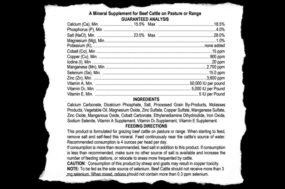Calves, fresh off the truck, are hardly what you’d call “fresh” in appearance. They walk the fences or stand hunkered-up and gaunt, are unfamiliar with their feed, water and surroundings, and are stressed.
Stress, in turn, causes them to produce stress hormones like glucocorticoids and catecholamines. These stress hormones are known to negatively impact nearly all aspects of immunity.
Our industry’s procedures have inadvertently set calves up for sickness and poor performance. Research conducted by John Richeson, an animal science professor at West Texas A&M University, shows that traditional feedlot receiving procedures could limit the effectiveness of modified live vaccines (MLV) if they are administered to chronically stressed calves.
Richeson says, “Postponing MLV vaccination until cattle are no longer in a stress condition may be beneficial to cattle in any production scenario (stocker, feedlot or dairy) that are experiencing chronic stress-induced immunosuppression. I am cautiously recommending delayed MLV vaccination if the cattle are experiencing chronic stress.”
Stress defined
The term “stress” refers to all reactions to stimuli that disrupt an individual’s homeostasis and can include physical, mental or emotional causes. Stressors are any internal or external agent that disrupts homeostasis and creates a physiological response.
There are many different stressors in the life of a beef calf. Often, they are weaned in the trailer bound for the sale barn, where they are commingled and exposed to bovine respiratory disease (BRD) pathogens.
From there, they can be gathered at an order buyer’s lots where they are commingled again only to be loaded on a trailer headed for either a feedlot or stocker operation, where they are stressed by the change in climate, feed and water restrictions, and new social order. Then, on top of that, they are usually processed within hours of arriving at their destination.
Processing could include castration, dehorning, branding, deworming and vaccinations. This scenario would be termed “chronic stress” lasting up to a week or more. These sources of stress increase plasma cortisol for an extended period and weaken the immune response.
Chronic stress, acute stress and the immune system
This research conducted by West Texas A&M, in conjunction with the University of Arkansas, could change the way we process chronically stressed cattle at receiving, but we need to understand the difference between chronic stress and acute stress.
Chronic stress is more than 24 hours of additive stressors and can alter the animal’s ability to respond to vaccination. Acute stress, however, lasts less than 24 hours and is believed to actually prime the immune system for a better response to vaccination or a natural disease challenge.
There is a fascinating relationship between stress and the complex immune system, which consists of these overarching components: innate immunity and acquired immunity.
Innate immunity includes physical barriers such as skin, chemicals in the blood and immune system cells (such as macrophages and neutrophils) that attack foreign cells in the body.
Acquired immunity is developed over time; as the immune system encounters foreign substances (antigens), the acquired immune system determines the best way to attack the antigen and develops a database of sorts for specific antigens so it is more efficient at eliminating the antigen upon subsequent exposure.
MLV product labels from two manufacturers warn against treating stressed animals, stating that “Individual animals may be unable to develop an adequate immune response following vaccination due to: concurrent disease, malnutrition, parasitism or stress due to shipment or environmental conditions.” And “… use should be limited only to healthy, immunocompetent, unstressed cattle.”
Enter BRD
So now we’ve taken calves with naive or compromised immune systems, created a situation where they are under stress and exposed them to environments where causative agents of BRD are present. BRD is the most costly disease in beef cattle production in terms of death loss, poor performance and reduced carcass quality as well as costs associated with prevention and treatment.
BRD, a general term for respiratory disease in cattle, is usually caused by viral pathogens in concert with bacterial pathogens or parasitic and fungal pathogens. Unfortunately, these nasty pathogens work together with stress to create the perfect storm of bovine respiratory disease.
Perhaps it’s time for a paradigm shift. We’ve had a feedlot receiving protocol that has largely gone unquestioned for decades.
What the research shows
The research conducted by Richeson delayed administering the MLV for 30 days with the goal of evaluating the physiological response of delayed MLV.
After 116 days on feed, the delayed-vaccination treatment group had a reduced incidence of treatment for BRD as well as reduced overall treatment rate. The re-treatment rate for the delayed-vaccination group was 37.05 percent and 43.97 percent for the calves vaccinated at receiving. There was also a reduction in BRD mortalities in the delayed-vaccine group.
A consulting feedlot veterinarian who prefers to remain anonymous says, “We’ve been administering MLV at receiving in the feedlots for years, and we really haven’t seen any improvement in BRD control.
The bottom line is: There’s a positive response to delaying vaccination until calves have recovered from the significant stress of shipping and receiving as opposed to administering MLV at receiving; this is a huge shift from what we’ve done the last 40 years.”
While sold on the benefits of delaying MLV in many instances, some producers’ experience is that certain circumstances can change the risk level of selecting this protocol. Scott James, a Montana cattleman, says, “I feed at several yards in Montana, Kansas and Nebraska.
I have fed high-risk cattle for many years, and I am usually in touch with the feedyards on how I want the cattle vaccinated: MLV at initial processing. I have delayed MLV if weather conditions are good with no impending blizzards, rain, bad mud, etc.”
James says, “I’ve seen the research about delaying MLV and have tried it. It works great if you’re dealing with manageable numbers with decent weather. In a situation of starting a large number of high-risk cattle with less-than-ideal weather and lot conditions, coupled with limited knowledge of vaccination history, delaying MLV is a riskier proposition.”
The key is to consider the duration and intensity of physiological stress the cattle are experiencing as opposed to vaccinating on a schedule or at receiving simply because that is how it has always been done. Richeson says, “I think the timing or length of delay may need to be considered on a pen-by-pen basis, but I think a delay period of at least 28 days is probably best.”
Certain circumstances could necessitate an even longer delay. Richeson says, “In groups that have a late BRD outbreak several weeks after arrival, or those that may experience a significant stress event such as extreme weather around day 28, I think the delay period should probably be extended further.
We need more research in this area to determine the most appropriate length of delay, but the concept hinges on administering the MLV to non-stressed animals that have a fully competent immune system.”
This research is a game-changer for feedlot receiving protocols. More research needs to be done as pertains to the ranch and stocker operations, but with use of antibiotics under increasing scrutiny and regulation, it is important to improve disease prevention measures. ![]()
PHOTO: Chronic stress is more than 24 hours of additive stressors and can alter the animal’s ability to respond to vaccination. Photo by Melissa Beck.

-
Melissa Beck
- Freelance Writer
- Prescott, Arkansas
- Email Melissa Beck
Did you know?
$500 million
Bovine respiratory disease (BRD) has been estimated to cost the U.S. cattle industry over $500 million each year. It is the single biggest killer in the U.S. among newly weaned cattle.
—Source: Heidi Ward and Jeremy Powell, University of Arkansas.







